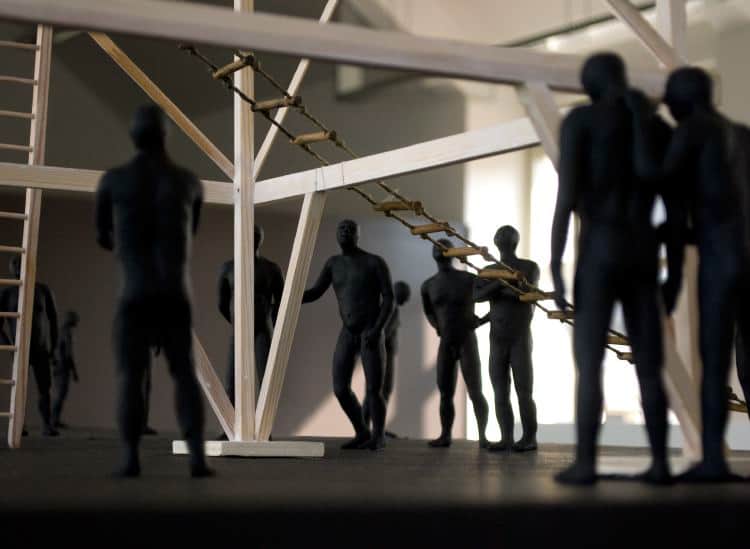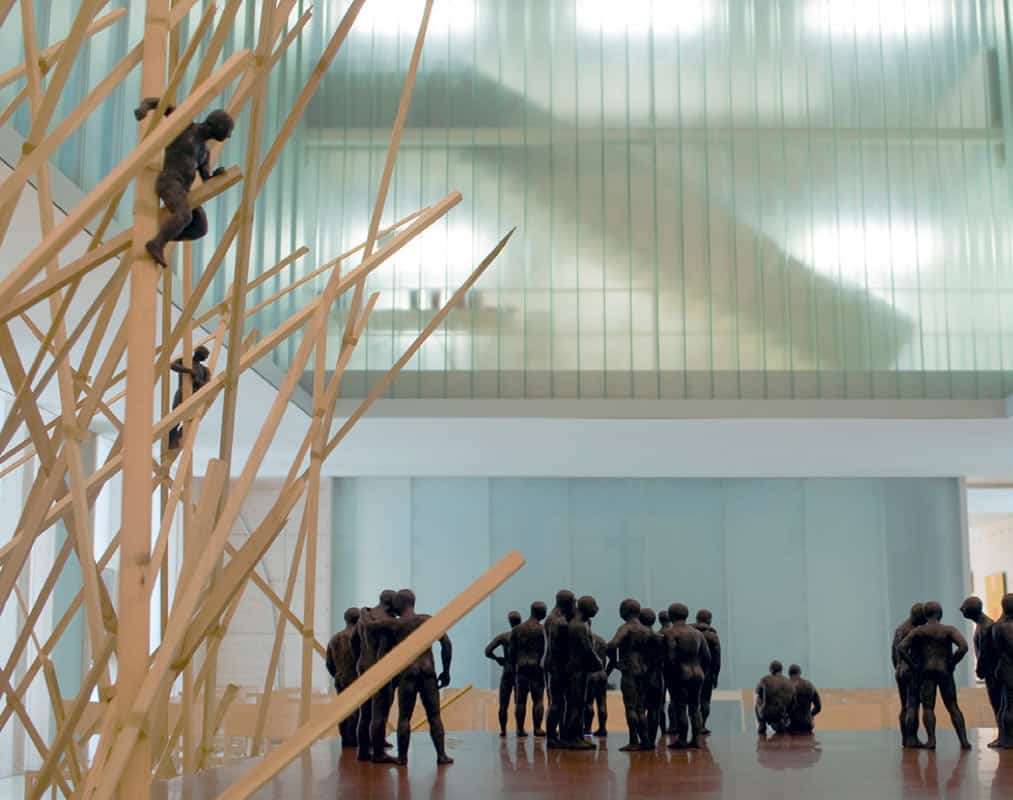non-figurative works…..figurative works.….exhibitions
non-figurative…..figurative
Alius Mundus 2012 Kunsthalle m3, Berlin
A life inside, another world. An installation of 4 cardboard ‘rooms’ containing ca. 80 figures, which could only be seen through peep-holes.
Short and Intense II 2011 Kurt-Kurt Projektzentrale, Berlin
A horde of figures take up residence in the storage room of Kurt-Kurt. They are only visible through a slot in the window covering, some directly, others only through reflections in a mirror.
70 Sculpey figures, video
Fremde Bewohner 2011 Frankfurt/Main
Installations in 3 sites in Frankfurt/Main:
Ground Level, Römer9
painted plinth, wooden tower, rope and wood ladders, Sculpey figures
Wave, Epiphaniaskirche
timber offcuts, Sculpey and wax figures
(pre-existing altar and cross by Wolfgang Winter and Berthold Hörbelt)
Everyman’s Home, Markuskirche
fired and painted clay
The Ideal Man 2011 ArToll, Bedburg-Hau
The ideal man – 75 versions made during a two-week residency at Artoll occupy a room, accompanied by more around the walls.
Wax figures, ink drawings
Ecke 2011 Galerie Nord, Berlin
Small men occupy a corner of the Galerie Nord
Cardboard structure, sculpey figures
White Tower 2011 Art on Lake, Museum of Fine Art, Budapest
Two bronze figures climb to the top of an 8-metre tower – where to from there?
Photos: Frank Ringwald
Nach oben, ICI BERLIN 2009 La Condition Publique, Lilles/Roubaix
A crowd of figures inhabit an entrance room to La Condition Publique, on scaffolding, packing cases, towers, ladders, shelves. Some of them are creeping in under the door.
Curated by Dr. Ralf Hartmann and Dr. Andrea Weber
Climb 2009 Waygood Gallery, Newcastle-upon-Tyne
Small figures, big room. But there are opportunities to move upwards.
Sculpey figures, rope and wood ladders, cardboard construction
Cellar 2007 Pince Galeria, Budapest
Plasticine figures emerge from the cellar walls in the depths of the Pince Galeria
Der Esel ist Tot 2006 Heimspiel Gallery, Frankfurt/Main (with Julia Oschatz)
Installation, performance and 25min animated film about our travels back from Cripple Creek, Colorado with bags of gold carried by Dennis the donkey (sadly bombed to bits in Palestine). The gold didn’t make it back either.
The House at Egg Stream 2004 Heimspiel Gallery, Frankfurt/Main
Installation and film about a woman living alone in a house by a wood.
Ain’t she sweet…? 2003 Zagreus Projekt, Berlin
I made self-portraits from sugar paste and marzipan at Konditorei Josef Fingerlos during a three-month residency in Salzburg, a city known for its sweet delicacies. Sugar played an important role in my life as I was highly allergic to it.
The exhibition represents an artistic questioning of “sweet” in relation to the audience’s reactions to the figures. The figures became “collaborators” in the performance during the opening. I entered their world and began a destructive game… If the audience thought “I” was so sweet, they could eat me…
A Breath of Fresh Air 1997 WheNever, Greatorex St. Synagogue, London
The Greatorex Street synagogue was no longer in use, the building had been squatted, set alight and flooded, and was in very bad repair. Without adding new components, I completely renovated the reception room to stand as a reminder that human intentions, wishes and energies are required to maintain a particular vision of the world. When these are withdrawn, atrophy gives rise to another order of reality that pays little heed to the desires of humans.
Walls have Ears 1996 Forgotten Present International Visual Arts Symposium, Vilnius
I made 5 masks following instructions from a Russian leaflet (printed the year I was born), found in an abandoned embassy. It gave instructions for making protective clothing in the event of nuclear fallout. I constructed an imaginary life for a woman who might have lived in this building and who may have carried out similar activities to me, an English woman: shopping, cooking, afternoon tea, going out and sleeping. I photographed myself in these rooms carrying out these activities. The masks were hung in the entrance and the 5 series of photographs were applied directly to the walls of the rooms.
Reactions to the work were sharply divided; those who had left Lithuania during WWII, or their descendants who wished to return, found the images disturbing, suffocating, whilst those who had always lived in Vilnius found them humorous – a humour rooted in anxiety?
All five masks ‘disappeared’ during the exhibition.
Object of Desire 1995 Gasworks Gallery, London
The surface as a barrier and the desire to permeate this barrier, in this instance unfulfilled, was the concept of Object of Desire. Layers of acetate, distorted by heat and trapping strands of hair, are wired together to form an enticing space that the viewer is barred from entering. The whole seductively gleams in projected light. Desire is frustrated. The viewer can only stand outside in reflections, projections, glimmers and shadows.
The Swaffham Collection 1995 Swaffham Town Hall
The Swaffham Collection was constructed from favourite, ‘precious’ items loaned or donated by the inhabitants of Swaffham, a town in Norfolk. These small ‘objects of desire’ were suspended in plastic bags in the windows of the Assembly Rooms, a central meeting place in the town.
They formed a filter through which one looked into or out of this place of collective activity.
Here’s Looking at You 1995 Back Row Bingo, former Regal Cinema, Norwich
Here’s looking at you – video installation in a disused cinema in Norwich on the stage where films were previously projected. Each monitor showed a 5-minute silent loop of members of a film audience. Here, the audience occupies the space of projection as both object and subject.
Split 1995 King’s Lynn Arts Centre
Installation in King’s Lynn Art Centre, a former storage depot. Split ‘extended’ the space of the gallery beyond its physical boundaries into an image of the internal private space where dreams and wishes exist. As viewers walked through the beams they peopled this illusory space as dark shadows, projections moving through a field of red light.
Forest Banquet 1994 Ajaloo Institute, Tallinn
Forest Banquet is a response to the many stories and myths about the Forest Brothers, men and women who served as guerrilla fighters against the Russians at the end of the 2nd World War. The extensive forests in Estonia remain a symbol of freedom, yet for many of the Brothers it was the site of their death.
Forest Banquet combines aspects of a memorial and a picnic, and considers the mythologising of heroism, which gives what must have a primitive and brutal existence a civilising patina as it recedes into history. The forest or the Brothers – who fed whom?




































































































